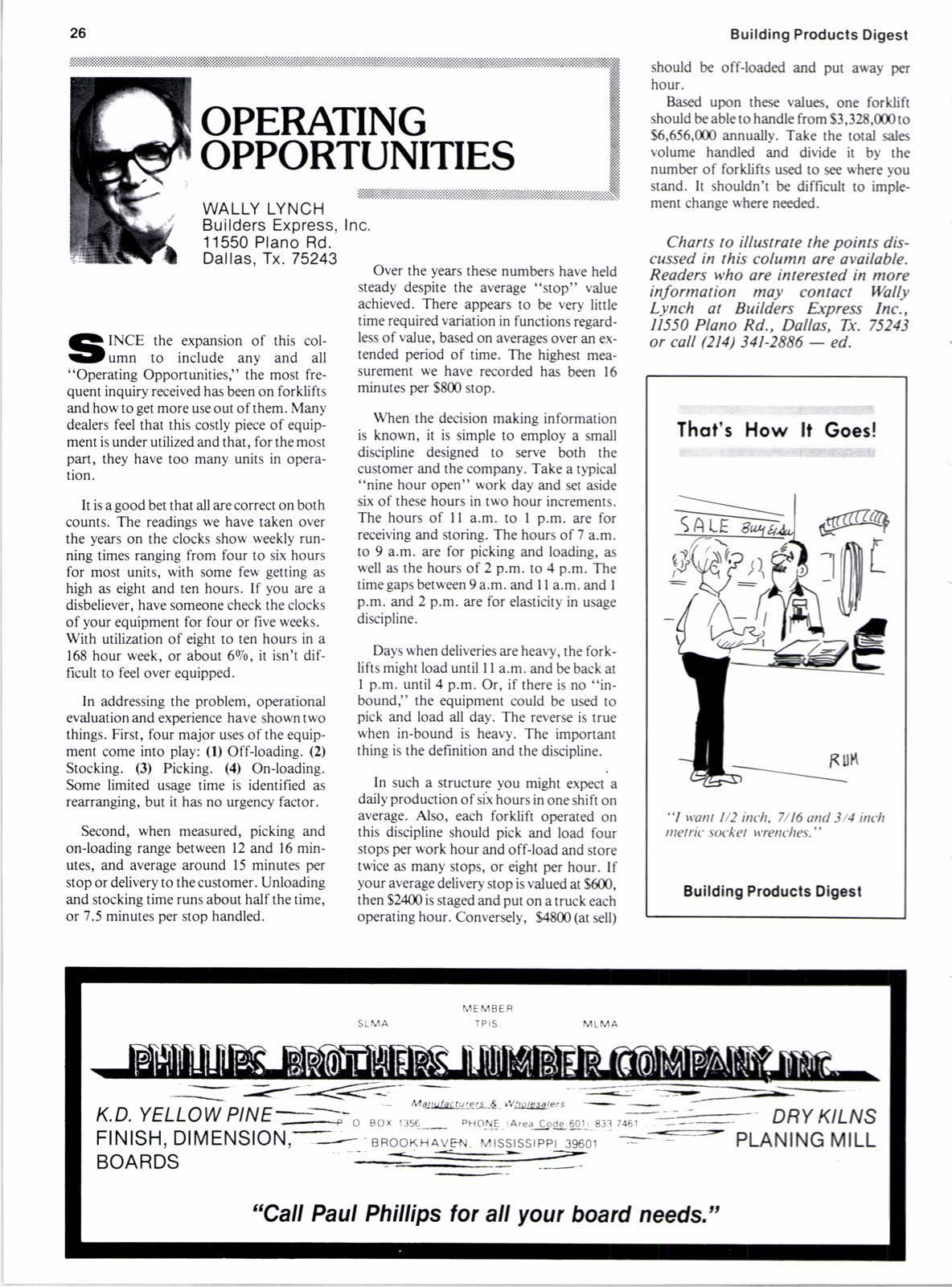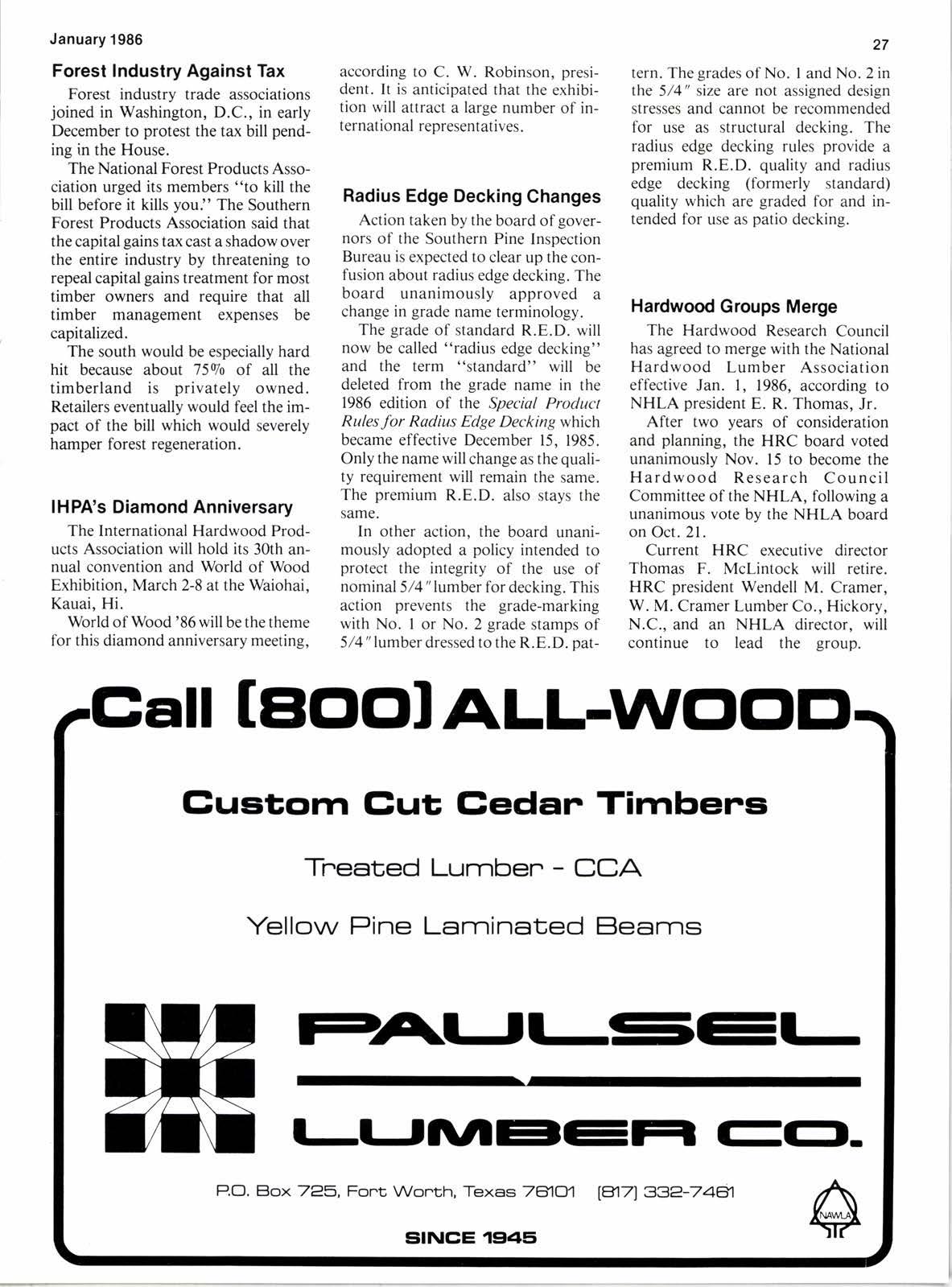
4 minute read
OPERATING OPPORTUNITIES
WALLY LYNCH Builders Express, 11550 Plano Rd. Dallas. Tx.75243
aE! INCE the expansion of this colClumn to include any and all "Operating Opportunities," the most frequent inquiry received has been on forklifts and how to get more use out of them. Many dealers feel that this costly piece of equipment is under utilized and that, for the most pan, they have too many units in operation.
It is a good bet that all are correct on both counts. The readings we have taken over the years on the clocks show weekly running times ranging from four to six hours for most units, with some few getting as high as eight and ten hours. If you are a disbeliever, have someone check the clocks ofyour equipment for four or five weeks. With utilization of eight to ten hours in a 168 hour week, or about 690, it isn't difficult to feel over equippec.
In addressing the problem, operational evaluation and experience have shown two things. First, four major uses of the equipment come into play: (l) Off-loadine. (2) Stocking. (3) Picking. (4) On-loading. Some limited usage time is identified as rearranging, but it has no urgency factor.
Second, when measured, picking and on-loading range between 12 and 16 minutes, and average around 15 minutes per stop or delivery to the customer. Unloading and stocking time runs about half the time, or 7.5 minutes per stop handled.
Over the years these numbers have held steady despite the average "stop" value achieved. There appears to be very little time required variation in functions regardless of value, based on averages over an extended period of time. The highest measurement we have recorded has been 16 minutes per $800 stop.
When the decision making information is known, it is simple to employ a small discipline designed to serve both the customer and the company. Take a typical "nine hour open" work day and set aside six of these hours in two hour increments. The hours of I I a.m. to I p.m. are for receiving and storing. The hours of 7 a.m. to 9 a.m. are for picking and loading, as well as the hours of 2 p.m. to 4 p.m. The time gaps between 9 a.m. and I I a.m. and I p.m. and 2 p.m. are for elasticity in usage discipline.
Days when deliveries are heavy, the forklifts might load until l I a.m. and be back at I p.m. until 4 p.m. Or, if there is no "inbound," the equipment could be used to pick and load all day. The reverse is true when in-bound is heavy. The important thing is the definition and the discipline.
In such a structure you might expect a daily production of sii< hours in one shift on average. Also, each forklift operated on this discipline should pick and load four stops per work hour and offload and store twice as many stops, or eight per hour. lf your average delivery stop is valued at $6{0, then 5240 is staged and put on a truck each operating hour. Conversely, $48(D(at sell) should be off-loaded and put away per hour.
Based upon these values, one forklift should be able to handle from $3,328,ffi to $6,656,m annually. Take the total sales volume handled and divide it by the number of forklifts used to see where you stand. lt shouldn't be difficult to implement change where needed.
Charts to illustrate the points dbcussed in this column are available. Readers who are interested in more information moy contact Wally Lynch at Builders Express Inc., 11550 Plano Rd., Dallas, Tx. 75243 or call (214) 341-2886ed.
Thol's How lt Goes!
Forest Industry Against Tax
Forest industry trade associations joined in Washington, D.C., in early December to protest the tax bill pending in the House.
The National Forest Products Association urged its members "to kill the bill before it kills you." The Southern Forest Products Association said that the capital gains tax cast a shadow over the entire industry by threatening to repeal capital gains treatment for most timber owners and require that all timber management expenses be capitalized.
The south would be especially hard hit because about 7590 of all the timberland is privately owned. Retailers eventually would feel the impact of the bill which would severely hamper forest regeneration.
IHPA's Diamond Anniversary
The International Hardwood Products Association will hold its 3fth annual convention and World of Wood Exhibition, March 2-8 at the Waiohai, Kauai, Hi.
World of Wood '86 will be the theme for this diamond anniversary meeting, according to C. W. Robinson, president. It is anticipated that the exhibition will attract a large number of international representatives.
Radius Edge Decking Changes
Action taken by the board of governors of the Southern Pine Inspection Bureau is expected to clear up the confusion about radius edge decking. The board unanimously approved a change in grade name terminology.
The grade of standard R.E.D. will now be called "radius edge decking" and the term "standard" will be deleted from the grade name in the 1986 edition of the Speciol Product Rules for Radius Edge Decking which became effective December 15. 1985. Only the name will change as the quality requirement will remain the same. The premium R.E.D. also stays the same.
In other action. the board unanimously adopted a policy intended to protect the integrity of the use of nominal 5/4 " lumber for decking. This action prevents the grade-marking with No. I or No. 2 grade stamps of 5/4 " lumber dressed to the R.E.D. pat- tern. The grades of No. I and No. 2 in the 5/4" size are not assigned design stresses and cannot be recommended for use as structural decking. The radius edge decking rules provide a premium R.E.D. quality and radius edge decking (formerly standard) quality which are graded for and intended for use as patio decking.
Hardwood Groups Merge
The Hardwood Research Council has agreed to merge with the National Hardwood Lumber Association effective Jan. l, 1986, according to NHLA president E. R. Thomas, Jr.

After two years of consideration and planning, the HRC board voted unanimously Nov. 15 to become the Hardwood Research Council Committee of the NHLA, following a unanimous vote by the NHLA board on Oct. 21.
Current HRC executive director Thomas F. McLintock will retire. HRC president Wendell M. Cramer, W. M. Cramer Lumber Co., Hickory, N.C., and an NHLA director, will continue to lead the group.










